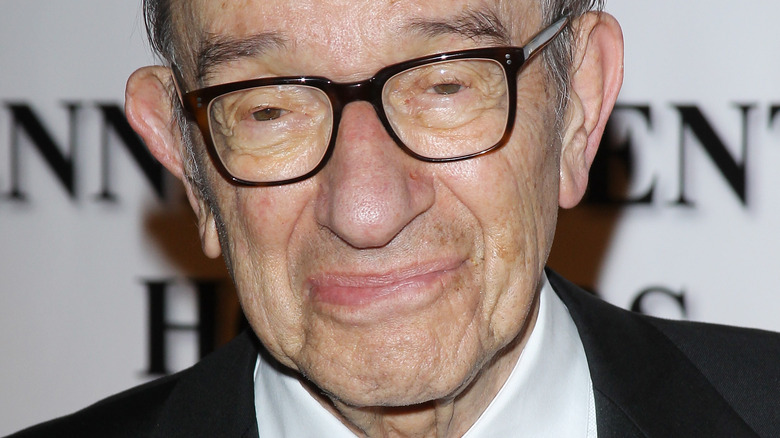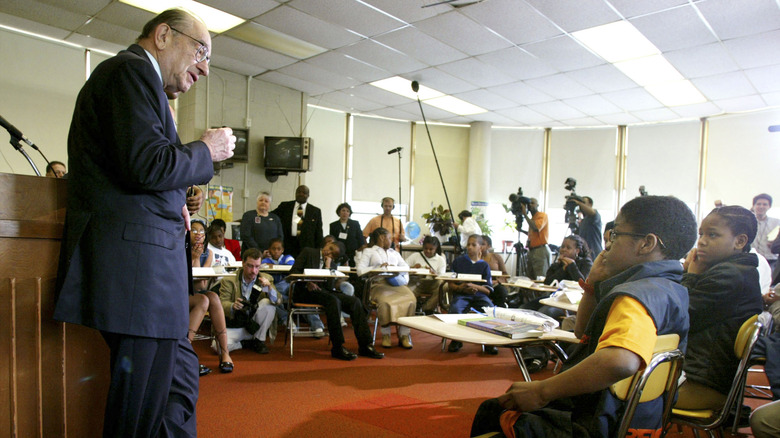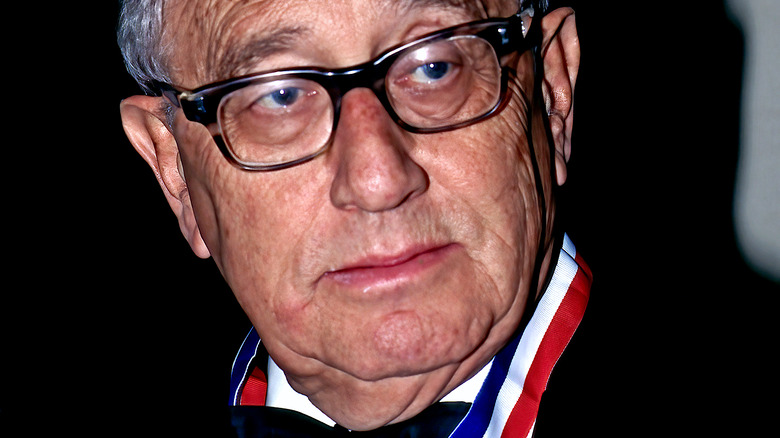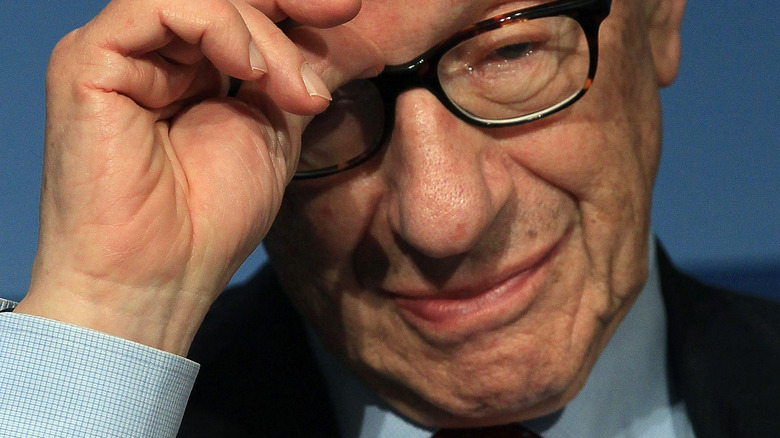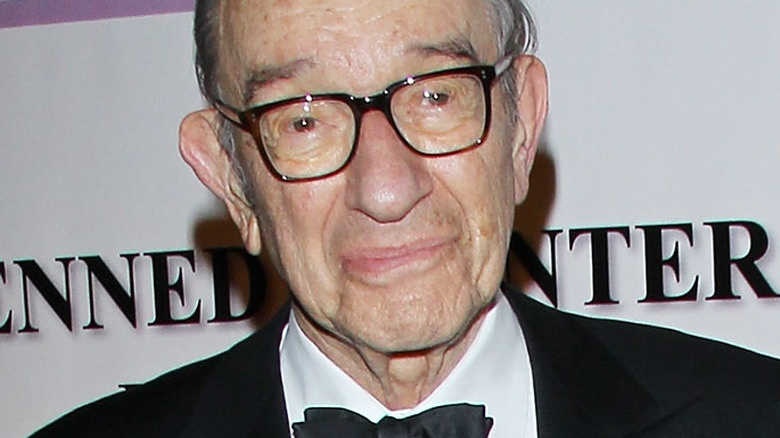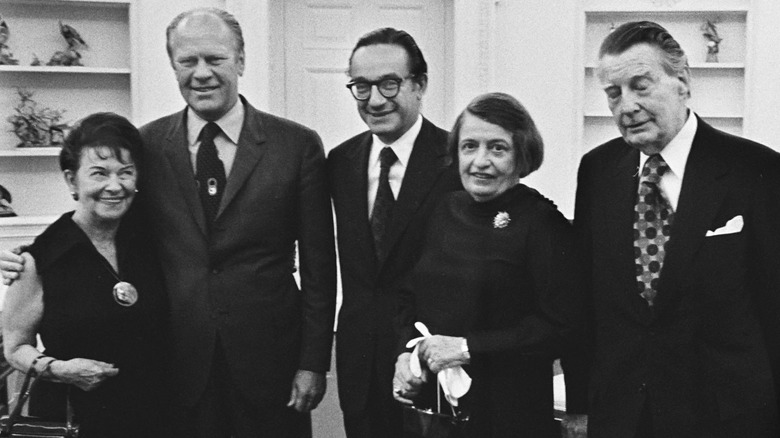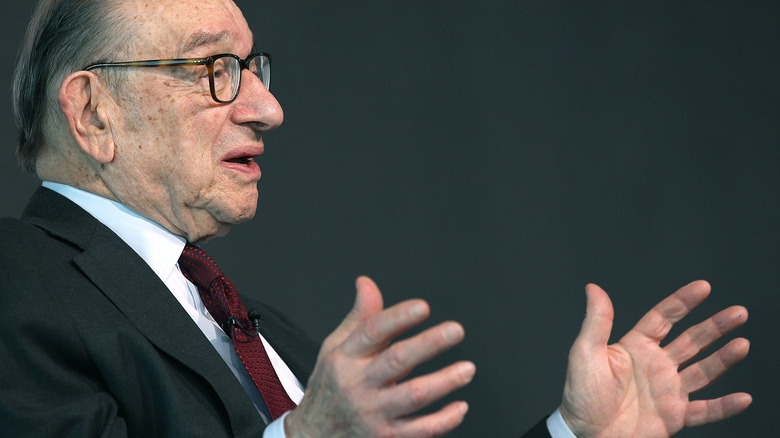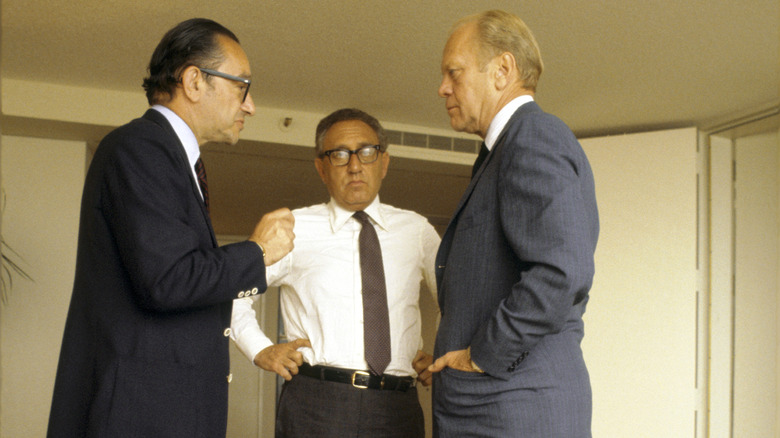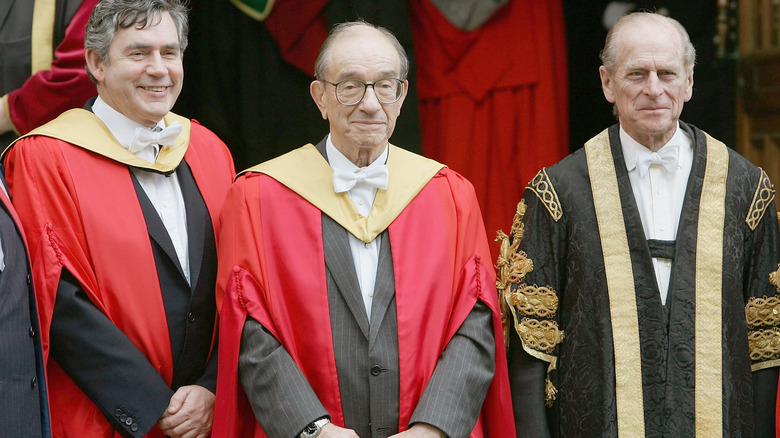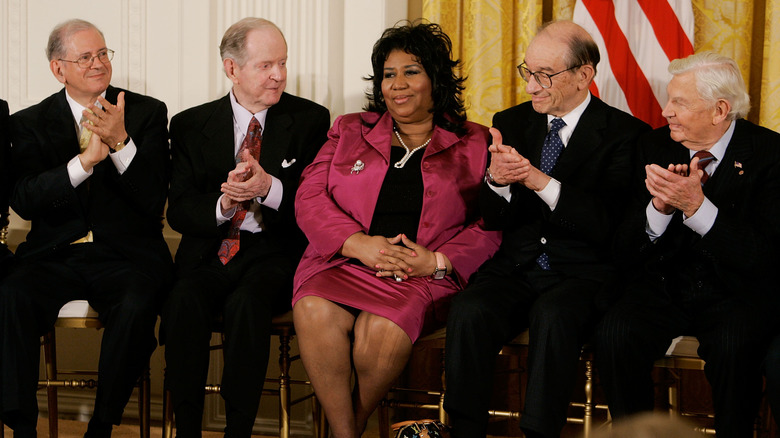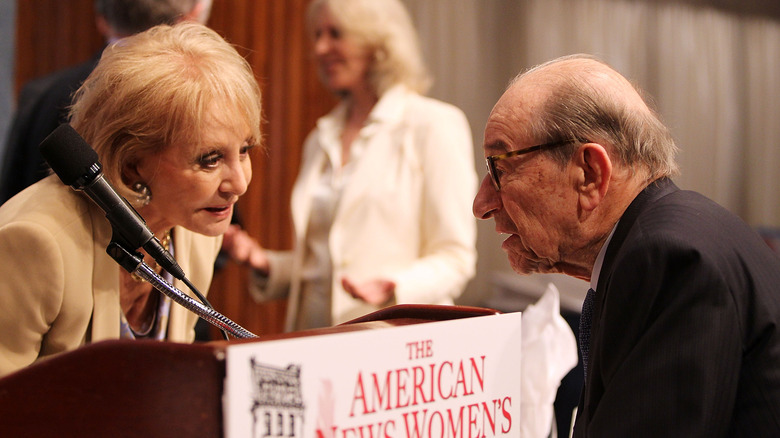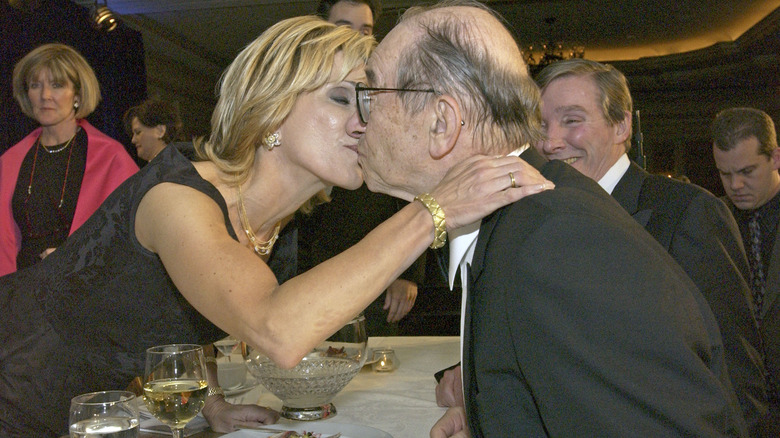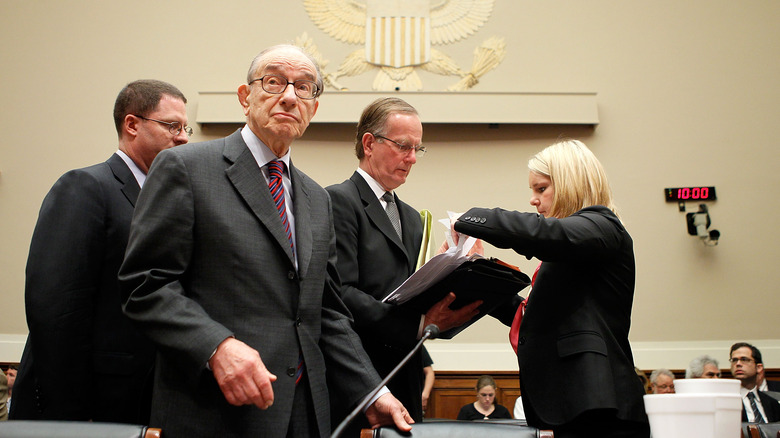Essential Facts About Alan Greenspan
Alan Greenspan is one of the longest-serving chairs of the Federal Reserve in U.S. history. After he was appointed, he quickly had to deal with the stock market crash of 1987, and he then remained in the position for nearly two decades until 2006. For his 2012 biography on Greenspan, Bob Woodward chose the title "Maestro," due to Greenspan's impressive understanding of economic policy. As Woodward explained, he chose the nickname "to convey that Greenspan is conducting the orchestra but does not play an instrument. He sets the conditions for the players to play well, if they so choose and if they are capable."
Yet, the maestro received a lot of criticism toward the end of his career as well, making him a rather polarizing figure. Many, for instance, blame Greenspan's policies as Fed chair for the recession in 2008, the worst financial crisis since the Great Depression. Love him or hate him, though, no one can deny the huge impact Greenspan has made on the country, and because of that, it's sometimes difficult to see the person behind the policies.
Like all great individuals, Greenspan is just a man under the surface — with his own quirks, hobbies, passions, and flaws, the same as everyone else. Here are some of the most fascinating of those details, as we take a look at the life of one of the greatest economists of modern times.
He aspired to be a baseball player as a kid
Growing up in New York City, one of Alan Greenspan's childhood obsessions became baseball, the same as with many other kids in his neighborhood. In his book, "Maestro," Bob Woodward commented on how Greenspan's parent's divorce caused him to move with his mother to Upper Manhattan and live with his grandparents. The new home brought him close to the Polo Grounds, which was not difficult for children to get in for free to see the Giants years before their switch to San Francisco.
But Greenspan admitted in his memoir, "The Age of Turbulence," that even though he couldn't watch their games as much, he zealously followed the Yankees in the newspapers. By the time he was 9 years old, he dreamed of becoming a professional ballplayer. He wrote, "I played on neighborhood teams, and I was pretty good — I'm a lefty, and I had the agility and reflexes to make a solid first baseman." Others took notice of his skills as well and one senior even told Greenspan he was on track to play for a major league team in the future.
Unfortunately, his steady improvement didn't last, for Greenspan then added, "But that is the very moment at which my progress stopped. I never fielded or hit as well after that season. I'd peaked at 14." On the other hand, baseball led to the boy's fascination with batting averages, which helped him to fully grasp fractions at a young age.
He attended a competitive high school with other famous individuals
In 1940, Alan Greenspan enrolled at not just one of the largest, but also one of the top, public schools in New York City, George Washington High School. The popular school had way more students attending than its capacity of 3,000, both because parents from outside the district fought to get their kids in and due to the influx of refugees from World War II.
One of these refugees was a classmate of Greenspan's, a Hungarian named John Kemeny, who would later work under the esteemed Albert Einstein. The mathematician then became famous after he created the BASIC computer programming language with his partner, Thomas E. Kurtz. In his memoir, Greenspan recalled an interesting interaction he had with Kemeny at school: "John hadn't been in America long and spoke with a heavy accent, but he was brilliant at math. I wondered if this might be at least as a result of superior schooling he'd received in Hungary. So, I asked, 'Is that because you're from Europe?'" However, the reply was not quite what Greenspan expected as Kemeny simply shrugged and said, "Everybody is."
Another famous student who attended George Washington around the same time as Greenspan was the accomplished, yet controversial, statesman Henry Kissinger (pictured above). However, according to The Washington Post, Kissinger was a few years behind Greenspan and as a result, it was too soon for them to meet as teens.
He was deemed unfit to serve in the Army
After Alan Greenspan finished high school and turned 18 years old in 1944, he expected to be drafted into the Army just like thousands of others his age who served in World War II. However, at the induction center filled with hundreds of other draftees, Greenspan received shocking news. When he underwent the required medical examination, a tuberculosis specialist could not confirm or deny that a spot found on his lung was malignant, which immediately disqualified him from fighting in the war
In his book "The Man Who Knew," Sebastian Mallaby explained how Greenspan felt little relief for not having to face combat because of the great fear he then felt over the possibility he could perish from his condition. Not knowing how much time he had left in the world, the young man fully devoted himself to the passion he loved, music.
He was a member of the Henry Jerome Band
Instead of attending a traditional college after high school, Alan Greenspan enrolled at the Institute of Musical Art, now known as the Juilliard School of Music. He took classes in both clarinet and piano, but then dropped out after two years. Sebastian Mallaby says his reason for leaving was that the respected institution was far too formal in its approach, so Greenspan sought instruction from someone who more suited his style, which he found in his new teacher, Bill Sheiner. It was from Sheiner that Greenspan would learn the Henry Jerome band was looking for a clarinet and sax player.
Jerome was impressed with Greenspan at his audition and was brought on to tour across the U.S. with the swing act for over a year. Greenspan's primary position was the tenor saxophone, though he also filled in with the clarinet and flute at times. The young musician played well yet was unable to improvise like other more talented performers and he was aware of his limitations, according to Bob Woodward. As the bookkeeper for the band, Greenspan realized he had more skill with numbers, so he left the group to study economics at New York University.
Ayn Rand was a good friend
In 1952, Alan Greenspan tied the knot with art historian Joan Mitchell, and even though the marriage only lasted for around a year, it was through her that he met the revolutionary libertarian author Ayn Rand (per The Washington Post). Before long, Greenspan began to attend casual meetings with Rand's inner circle of friends, which they called the Collective as an inside joke since that mentality was the last thing the freedom-loving crew desired. From these gatherings, Rand came up with the nickname "The Undertaker" (via The Economist) for Greenspan due to his often-serious demeanor and choice of dark attire.
In his memoir, Greenspan recalled the impact the economic philosopher made on him and said, "Ayn Rand became a stabilizing force in my life. It hadn't taken long for us to have a meeting of the minds — mostly my mind meeting hers — and in the '50s and early '60s I became a regular at the weekly gatherings at her apartment. She was a wholly original thinker, sharply analytical, strong-willed, highly principled, and very insistent on rationality as the highest value."
Greenspan greatly respected Rand and considered her such a good friend that she stood at his side when he took the oath of office to serve as chairman of President Gerald Ford's Council of Economic Advisers. But according to Bob Woodward, Greenspan was too independent with both his own philosophy and social activities to ever really be considered a devout follower of Rand. Regardless, the two remained close until Rand passed away in 1982.
He established Townsend-Greenspan & Co. with William Townsend
In 1953, Alan Greenspan put his expertise in economics to good use by collaborating with bond trader William Townsend to create the consulting firm, Townsend-Greenspan & Co. His partner, Townsend, had previous experience with the establishment of Townsend-Skinner in the 1930s, however, it didn't take long for Greenspan to become the principal owner of the new firm by 1958 (per The New York Times). The company was a small enterprise with no more than 35 employees at most, and Greenspan made sure he was a part of decisions made at every level of the firm.
Greenspan thoroughly enjoyed leading his own business because of the freedom it gave him. According to Bob Woodward, the CEO of a much larger brokerage house once made a massive offer for the company a few years after Greenspan had sole control of the firm and the economist could not deny that he was enticed to sell. Yet, after contemplating the decision for a couple of days, he began to have stomach pains and came to the conclusion that it was his body's way of telling him to say no. So, Greenspan declined the offer in order to maintain his prized independence.
Though nothing lasts forever, Greenspan was forced to leave the company after he stepped up to become chair of the Federal Reserve in 1987. Those who remained at the firm attempted to replace the head of the company, but were unfortunately unable to find the right candidate in the short amount of time they had before Greenspan needed to leave.
Volunteering for Richard Nixon was his introduction to politics
Alan Greenspan's involvement in politics began in 1967 when he became a volunteer for Richard Nixon's presidential campaign. Only a year later, Greenspan was chosen as an economic policy adviser to the candidate, and in 1974, Nixon tapped him to become the next chair of the Council of Economic Advisers (via TIME).
Greenspan was very impressed with Nixon, especially for his ability to rapidly absorb information whenever he was briefed. When talking about Nixon in his memoir, Greenspan said, "He could listen for five minutes on a subject he couldn't possibly know much about — a breaking news event for instance — then get out there and sound as knowledgeable as a professor. I would say that he and Bill Clinton were by far the smartest presidents I've worked with."
After Nixon's resignation on August 8, 1974, President Gerald Ford kept Greenspan on as his own adviser, with Greenspan officially becoming chair on September 4. According to Bob Woodward, the economist gave the new president much credit for not intervening in the free market during the difficult recession of 1974-75.
He received the honorary title of knight
As an especially long-serving Federal Reserve chair, Alan Greenspan's efforts in maintaining economic stability around the world were appreciated by more than just members of the U.S. government. Officials at the UK Foreign Office also felt that he deserved recognition for all that he accomplished, a sentiment that was shared by Queen Elizabeth II as well. In 2002, her majesty bestowed an honorary knighthood upon the famous economist.
On the day of the ceremony, Greenspan said, "I am deeply appreciative of this honor which I shall always cherish" (via CNN). He later added, "This is an extraordinary event. We in the international community are especially grateful to our British forbears who several hundred years ago created so much of the financial infrastructure — and I suspect we probably take it for granted when we shouldn't" (via CBS News).
Because Greenspan was not a British citizen, the addition of "Sir" to his name was prohibited, but instead he gained the initials KBE at the end of his name, which means Knight Commander of the British Empire. Although it's rare for an economist to be acknowledged in such a manner, Greenspan's not the only U.S. citizen to be knighted, as the same honor has been received by several prominent figures, including Presidents Ronald Reagan, George Bush senior, Gen. Norman Schwarzkopf, and even Bob Hope.
The only Fed chair awarded the Presidential Medal of Freedom
In 2005, Alan Greenspan received an honor that had never before been given to a chair of the Federal Reserve when he was awarded the Presidential Medal of Freedom from George W. Bush (per The White House). Appointed Fed chair back in 1987, Greenspan had an impressive run in the position and served for five terms until the last one ended during Bush's presidency. Along with the economist, 14 other esteemed individuals received the highest civilian award at the ceremony as well, including boxer Muhammad Ali, singer Aretha Franklin, scientist Robert Kahn, General Richard B. Meyers, and actor Andy Griffith, according to CBS News.
Before the president gave Greenspan his medal, there was a brief, yet very complimentary introduction stating, "He has become the standard by which central bankers are measured. The United States honors Alan Greenspan for his outstanding career of public service and for enhancing the character and prosperity of our nation" (via CNN).
Barbara Walters and Alan Greenspan dated
Alan Greenspan didn't find his true love and current wife until later in life, but during his bachelor years, he did have a relationship with another high-profile professional in news media, Barbara Walters. The couple met in 1975 at a tea dance held by Vice President Nelson Rockefeller in Washington D.C., and the two dated on and off for several years afterward.
Walters was with Greenspan when she had to make one of the most difficult decisions of her career. As he explained in his memoir, ABC News was willing to give her a massive contract worth $1 million a year if she would leave NBC's "Today Show" for their network, and he was there every step of the way to offer any advice he might have in the transition. Walters confirmed this herself in her own memoir, "Audition," writing, "Alan, it should be noted, was at my side throughout the time, and I don't know how I would have gotten through it all without his wisdom and support."
Even though Walters and Greenspan continued to care deeply about each other, their relationship eventually came to an end, but at no specific point in time. Walters admitted, "Alan and I never actually broke up, but when a relationship doesn't grow, it gradually diminishes. We didn't want to marry and in those days we couldn't live together." Later, they were fortunate in that both found love with other partners who they married instead.
Ruth Bader Ginsburg officiated his marriage
While Alan Greenspan spent 44 years of his life as a bachelor, he dated various women, from beauty queens to news anchors, and senators. Yet, his predominantly unattached mentality changed dramatically after he met his future wife, Andrea Mitchell. Not only did Greenspan kiss his bride during the ceremony with a level of passion some may not have expected from the economist, but he also proudly declared, "I intend to make her happy and I will succeed" (per "The Man Who Knew").
The wedding was held in 1997 at a small, beautiful inn located in Virginia about an hour outside of Washington D.C. Among the many guests were quite a few well-known people, like Colin Powell, Henry Kissinger, and Greenspan's ex-girlfriend, though close friend, Barbara Walters.
One fascinating tidbit about the event involved an attendee who wasn't a guest, but rather the person who officiated the wedding, Supreme Court Justice Ruth Bader Ginsburg. At the time, the most recent justice had her seat on the highest court of the land for only a few years after the senate had confirmed President Bill Clinton's nomination in 1993 (via Britannica).
He was indirectly a part of The Economist domain name controversy
In 2008, when one entered theeconomist.com into their web browser, the page that came into view simply had a picture of Alan Greenspan, along with the words, "the economist of the century" (via The Register). Most probably would've just thought the site was funny or weird, but one established institution was not amused in the slightest. The Economist, a popular magazine from the UK that distributed its weekly issues to international audiences across the globe, felt the domain name should belong to it instead.
So, The Economist took its case to the World Intellectual Property Organization (WIPO) to resolve the issue and grant the publication full control. Yet, the only way the dispute resolution service could lawfully seize the address and hand it over was to prove if the owner, Jason Rose, had registered the domain in bad faith back in 1996. Rose claimed he had no idea what The Economist was, which the publication found quite ridiculous since at that time it had been in existence for 165 years, according to The Baltimore Sun.
Without sufficient evidence to prove his statements were false, however, WIPO could do nothing and Rose retained his control of the domain. The image of the former Fed chair is no longer on the site, but to this day, the web address of The Economist remains just economist.com.
